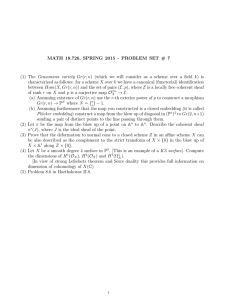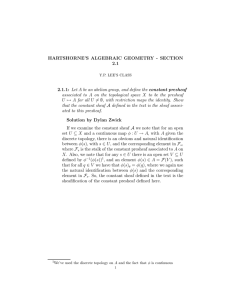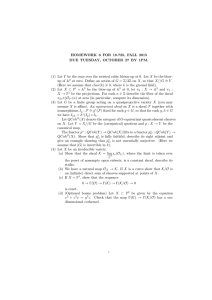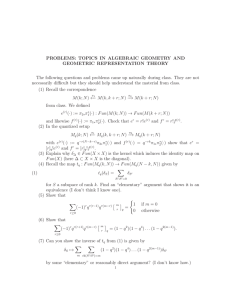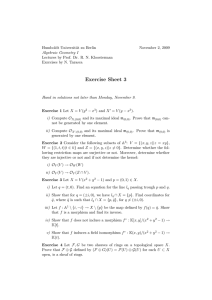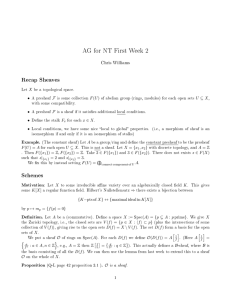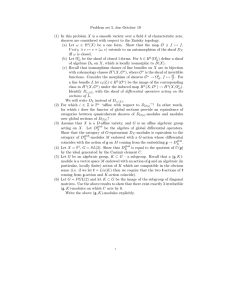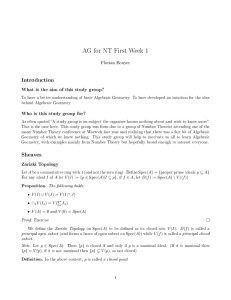Worksheet Renzo’s math 676
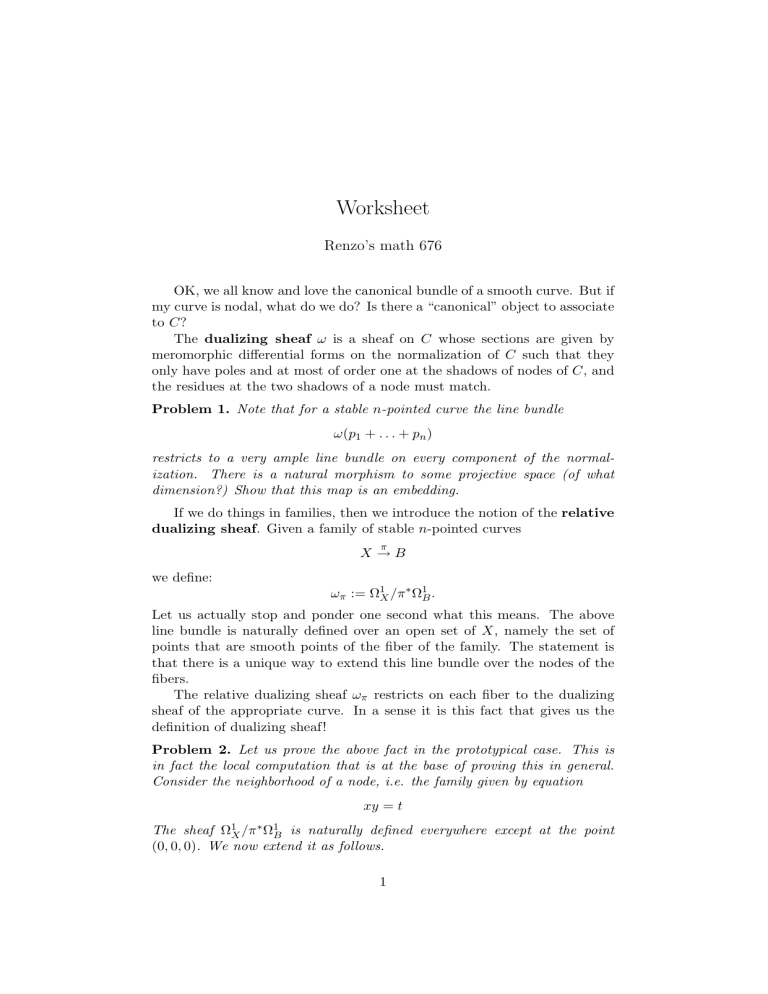
Worksheet
Renzo’s math 676
OK, we all know and love the canonical bundle of a smooth curve. But if my curve is nodal, what do we do? Is there a “canonical” object to associate to C ?
The dualizing sheaf ω is a sheaf on C whose sections are given by meromorphic differential forms on the normalization of C such that they only have poles and at most of order one at the shadows of nodes of C , and the residues at the two shadows of a node must match.
Problem 1.
Note that for a stable n -pointed curve the line bundle
ω ( p
1
+ . . .
+ p n
) restricts to a very ample line bundle on every component of the normalization. There is a natural morphism to some projective space (of what dimension?) Show that this map is an embedding.
If we do things in families, then we introduce the notion of the relative dualizing sheaf . Given a family of stable n -pointed curves
X → B we define:
ω
π
:= Ω
1
X
/π
∗
Ω
1
B
.
Let us actually stop and ponder one second what this means. The above line bundle is naturally defined over an open set of X , namely the set of points that are smooth points of the fiber of the family. The statement is that there is a unique way to extend this line bundle over the nodes of the fibers.
The relative dualizing sheaf ω
π restricts on each fiber to the dualizing sheaf of the appropriate curve. In a sense it is this fact that gives us the definition of dualizing sheaf!
Problem 2.
Let us prove the above fact in the prototypical case. This is in fact the local computation that is at the base of proving this in general.
Consider the neighborhood of a node, i.e. the family given by equation xy = t
The sheaf Ω
1
X
/π
∗
Ω
1
B is naturally defined everywhere except at the point
(0 , 0 , 0) . We now extend it as follows.
1
1. Consider two open charts U x
:= { x = 0 } and U y
:= { y = 0 } .
2. Write down the regular sections of Ω
1
X and U y
.
/π
∗
Ω
1
B on the two open sets U x
3. We can extend the sections to the point (0 , 0 , 0) as meromorphic sections. Now we want to retain the meromorphic sections that restrict to being holomorphic on U x and U y when you apply the appropriate transition functions.
4. Check the condition above precisely allows poles of order one over the point (0 , 0 , 0) and matching residues.
When the total space of the family is smooth, we can actually express the relative dualizing sheaf as:
ω
π
:= ω
X
⊗ ( π
∗
ω
B
)
∨
.
Problem 3.
Let us check that this works for our prototypical family xy = t.
1. Away from the point (0 , 0 , 0) one can use local coordinates ( x, t ) or
( y, t ) and the fact is more or less obvious.
2. At (0 , 0 , 0) use local coordinates ( x, y ) .
A section of ω
X f ( x, y ) dx ∧ dy . A section of ω
∨
B has the form f ( t )
∂
∂t
.
has form
3. Use the chain rule to express the pullback of such a section in terms of x and y .
4. Finally observe that the sections of the tensor product give us precisely meromorphic forms with one poles at (0 , 0 , 0) and cancelling residues.
Fact: The relative dualizing sheaf commutes with base change! I.e. it pulls back in cartesian diagrams! This is extremely important even if we do not prove it.
Problem 4.
Given a family of stable n -pointed curve as above, the morphism induced by the line bundle
ω
π
( s
1
+ . . .
+ s n
) gives an embedding of the family to B ×
P n − 2
.
Now start from a family X f of stable ( n + 1)-pointed rational curves
B f
→ M
0 ,n
2
and consider the map
B
π n +1
◦ f
→ M
0 ,n consisting in forgetting the ( n + 1)-st point and giving rise to the family
X
π n +1
◦ f
. We have a corresponding contraction morphism.
ε : X f
→ X
π n +1
◦ f
.
Show that this contraction morphism is associated to the line bundle ω
π
( s
1
+
. . .
+ s n
).
Problem 5.
Show that this construction gives the relation:
ω f
( s
1
+ . . .
+ s n
) = ε
∗
( ω
π n +1
◦ f
( εs
1
+ . . .
+ εs n
))
Problem 6.
Do the above construction universally, i.e. when B = M
0 ,n +1 and f = Id . Consider the diagram:
X
Id E
E
E
E
E
E
E
E
E s n +1
M
X
π n +1
M u u
Id.
u u u u u u u
π n +1
0 ,n
Π n +1
0 ,n +1
M
π n +1
0 ,n
Note: What is the composition Π n +1
◦ ◦ s n +1
?
Using this fact deduce a new formula for ψ i of the relive dualizing sheaf on M
0 ,n in terms of the Chern class
(note that the usual definition expresses it in terms of the relative dualizing sheaf on M
0 ,n +1
).
Problem 7.
Check this formula for n = 4 , 5 .
3
